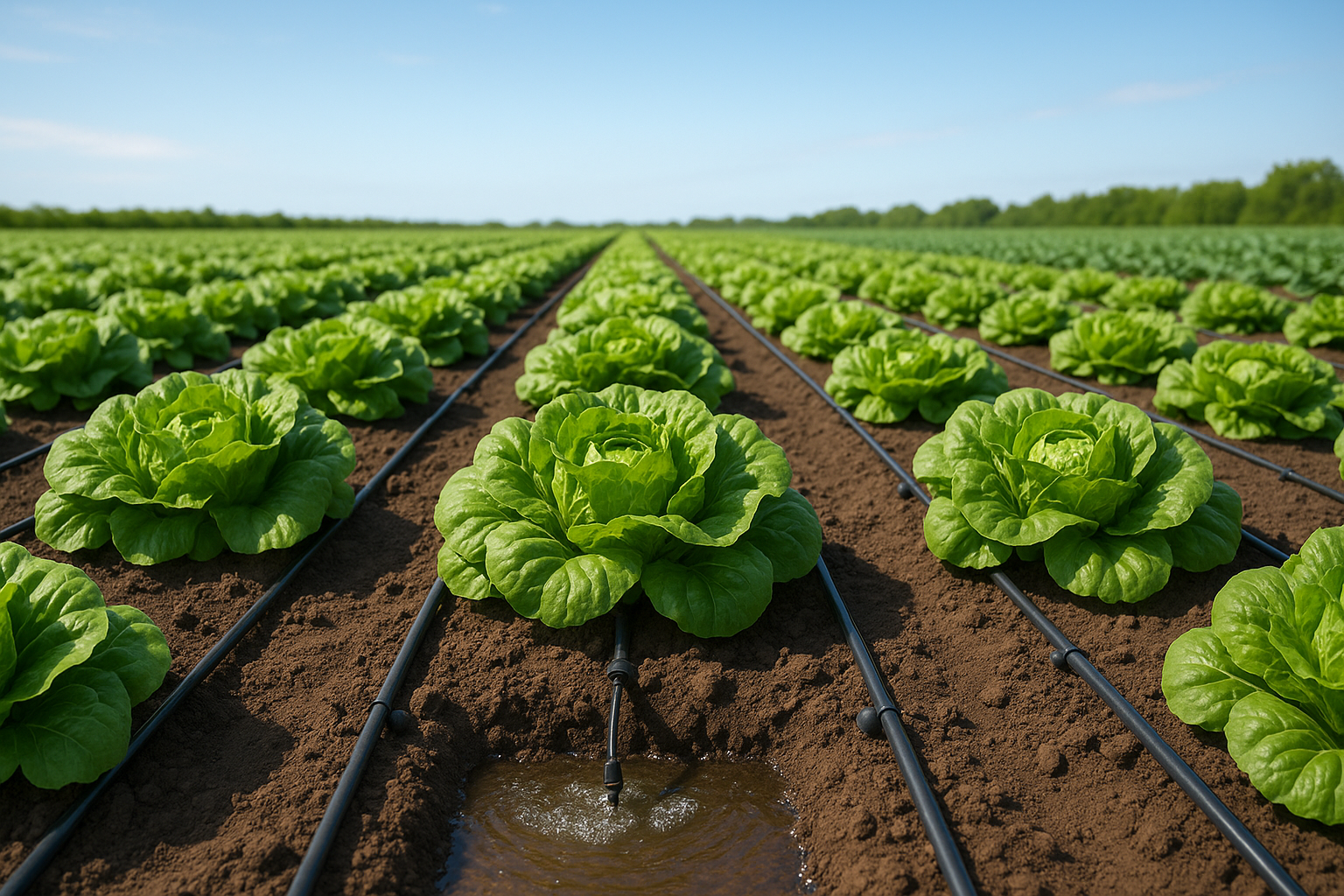Introduction to Lettuce and Its Water Needs
Drip irrigation for lettuce is quickly becoming a game changer for both commercial and backyard growers. Lettuce is a staple leafy green, prized for its crisp texture and quick turnaround from seed to harvest. Its popularity spans from vast commercial farms to small urban gardens, making it a favorite among those seeking a reliable, profitable, or simply tasty crop.
However, growing healthy lettuce comes with its own set of challenges—most importantly, meeting its demanding water needs. Lettuce roots are shallow, and the plants are sensitive to both under- and over-watering. Too little moisture can lead to bitter leaves and stunted growth, while inconsistent or excessive water can encourage rot and disease. This means consistent, targeted irrigation is absolutely essential for growing lettuce successfully.
That’s where drip irrigation for lettuce shines. Unlike overhead sprinklers that can waste water and invite leaf disease, drip irrigation delivers water slowly and directly to the root zone. This reduces evaporation and ensures each lettuce plant receives just the right amount it needs. Whether you’re looking to boost yields in a large field or hoping to save time and water in your home garden, switching to drip irrigation can simplify your routine and help your lettuce thrive.
Why Choose Drip Irrigation for Lettuce?
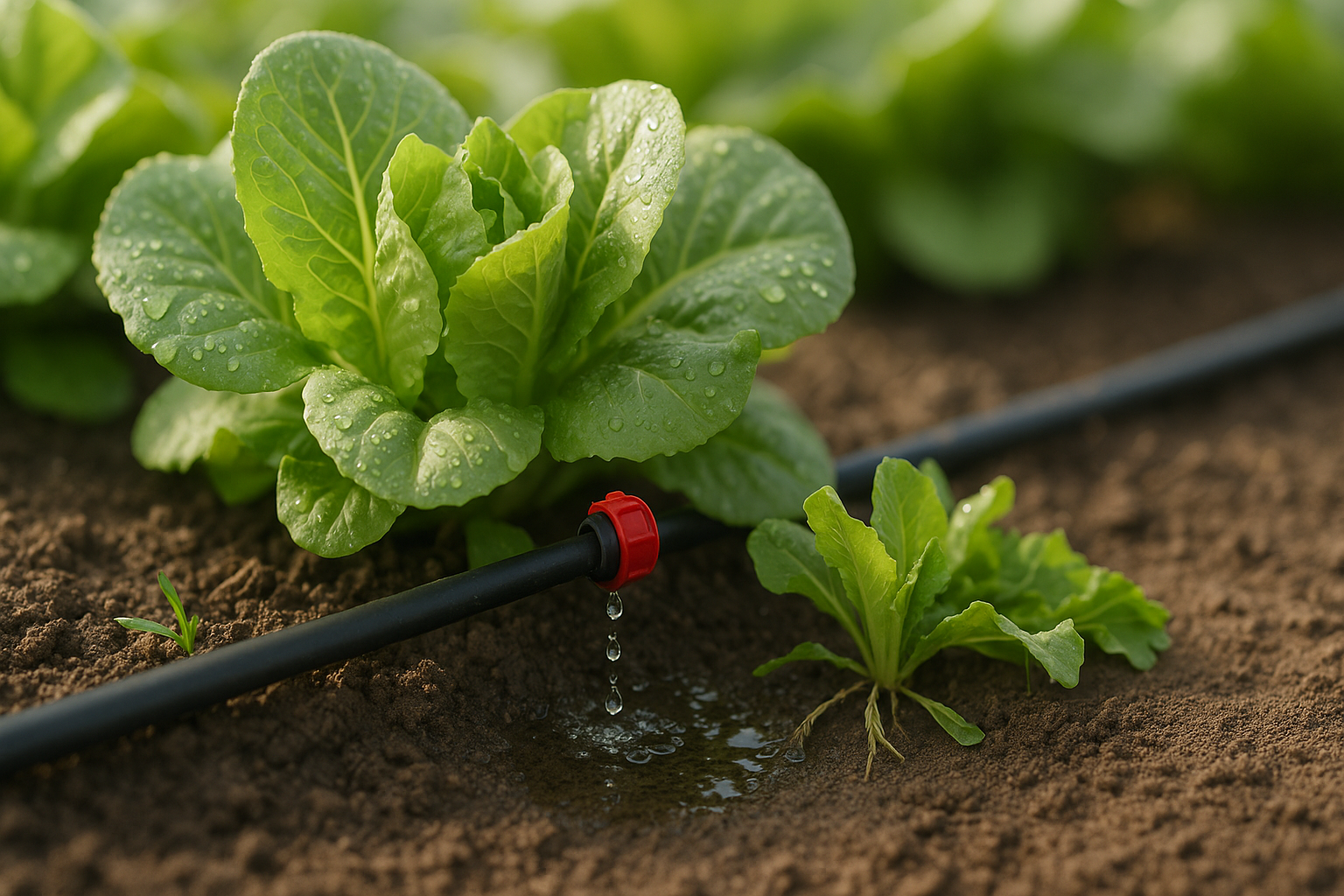
Drip irrigation is an ideal choice for growing lettuce, especially when compared to traditional overhead sprinklers or furrow irrigation. One key advantage is superior water efficiency. Drip systems deliver water directly to the plant’s root zone, minimizing evaporation and runoff commonly seen with overhead sprays or open ditches. This precision means you can use significantly less water while still maintaining healthy, vigorous plants.
Lettuce also benefits from the uniform moisture that drip irrigation provides—roots consistently receive just the right amount, reducing stress and promoting steady growth. Another major plus is reduced leaf wetness; because drip lines deliver water below the foliage, leaves stay dry, which is crucial in preventing fungal diseases like downy mildew and botrytis. These diseases often thrive in humid, wet environments created by overhead watering.
Over time, switching to drip irrigation also results in meaningful cost savings. Efficient water use translates to lower water bills, and fewer disease outbreaks mean you’ll spend less on fungicides and crop treatments. Environmentally, the reduced runoff and efficient application lessen the potential for nutrient leaching and groundwater contamination.
To illustrate, many commercial lettuce growers who have switched to drip irrigation have reported not only healthier crops but also a noticeable reduction in water and chemical use. If you’re looking for a smarter, greener, and more productive way to grow lettuce, drip irrigation is a solution worth considering for both your wallet and the planet.
Planning Your Drip Irrigation System
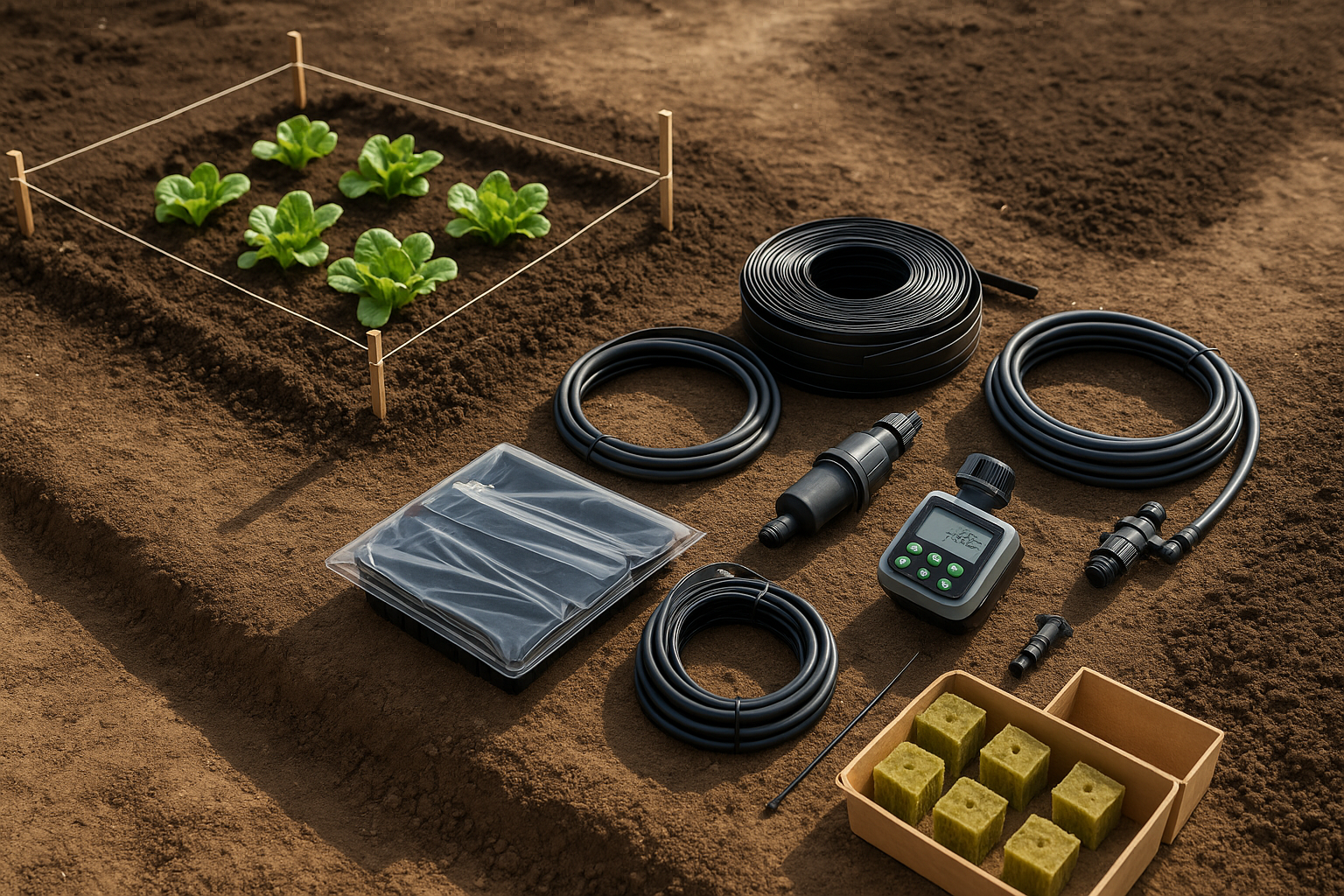
Before installing a drip irrigation system for your lettuce field, start with a detailed assessment of your land. Walk your field to note its size, shape, slopes, and any uneven areas, since these factors impact water distribution. Lettuce is usually planted in rows 8-12 inches apart, so measure your plant spacing to decide how many drip lines you’ll need per row.
Soil type plays a big role: sandy soils drain quickly and may need more frequent watering, while clay holds moisture longer but risks overwatering if not monitored. Next, estimate your lettuce’s water requirements. During seedling stages, lettuce needs about 0.1-0.2 inches of water per day, increasing as leaves develop. Factor in your local climate—hot, windy days mean your crop will need more frequent watering.
You can use simple tools like a soil moisture meter or check for moisture at root depth to fine-tune your schedule. To get started, gather key equipment:
- A sturdy main supply line (usually a 1-inch poly tube)
- Drip tape or emitters (look for ones releasing 0.5 to 1 gallon per hour)
- A high-quality filter to prevent clogging
- A pressure regulator to keep water flow steady (typically 10-20 psi)
- A timer or controller to automate irrigation and save labor
Before buying, jot down a quick checklist:
- Field map with dimensions
- Number of rows
- Required drip tape length
- Main line size
- Filter
- Regulator
- Timer
A well-planned system saves time, water, and helps your lettuce thrive.
Step-by-Step Guide to Installation
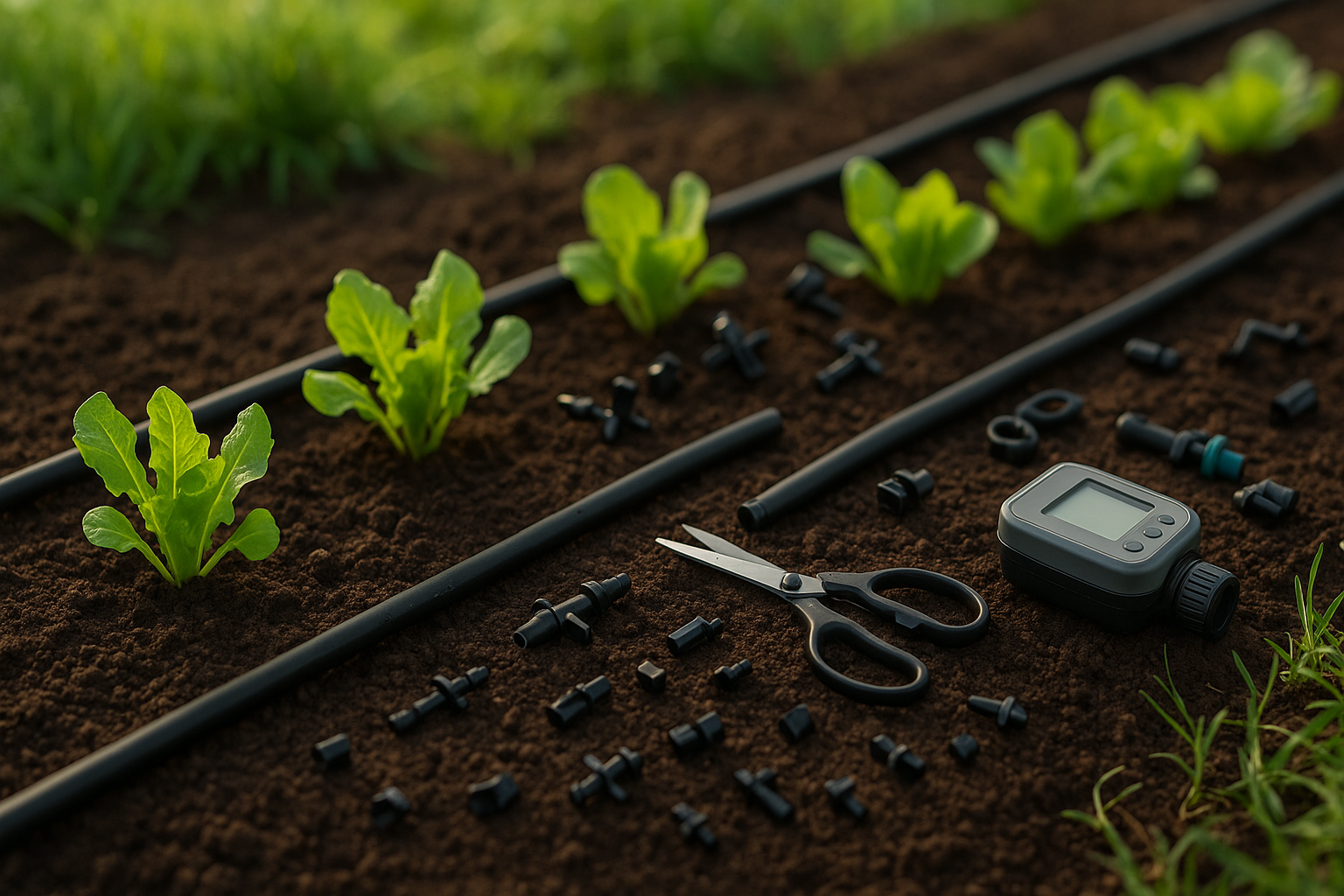
Getting started with your irrigation system begins with smart site preparation. First, clear the area of rocks, weeds, and debris to create an even workspace—this helps prevent damage to your lines and emitters later on.
Next, measure and mark your lettuce bed rows using stakes and string to ensure neatness and proper spacing. This will guide your irrigation layout.
Lay out your main line parallel to the rows, then run lateral lines perpendicular so that every lettuce row has access to water. When placing emitters, match the spacing to your lettuce crop, usually about 10 to 12 inches apart for head lettuce. Place the emitters close to the base of each plant for the best root coverage.
Once all parts are connected, turn on the system briefly to flush out dirt, then check for leaks at every joint and from the emitters. Tighten connections or replace fittings as needed until the system runs smoothly.
Walk the rows to see if every emitter is delivering a similar output. For an easy check, place a small container under a few emitters for a minute and compare the water volume.
To avoid trips and tangles, secure all exposed lines with stakes or bury them a few inches underground, especially in high-traffic garden paths.
Make it a habit to inspect your irrigation periodically and adjust emitter placement if you notice dry patches. Just a few simple checks can keep your lettuce happy and healthy all season.
Irrigation Scheduling and Maintenance
Setting an effective drip irrigation schedule for lettuce is all about balance. This leafy crop prefers consistent, shallow moisture and is sensitive to both drought and waterlogging. Start by irrigating early in the morning and adjust the frequency based on the weather—every one to three days when it’s cool, and possibly daily during heat waves.
Check the soil moisture about two inches deep; it should feel damp but not soggy. Smart controllers or simple moisture sensors can help automate this, but regular hand-checks give you better insight into the actual needs of your plants.
Maintenance Tips
Maintenance is just as important as timing. Flush lines every couple of weeks to clear sediment, and clean filter screens monthly—or more often if your water is hard or debris-prone—to keep the flow consistent. Each season, inspect hoses for cracks and ensure emitters are snug but not over-tightened to avoid leaks.
Common Issues and Fixes
Common drip system issues include clogged emitters, usually caused by mineral deposits or algae. You can quickly fix these by soaking clogged parts in vinegar or running them under high-pressure water. If you notice uneven watering—such as some lettuce rows looking wilty while others are thriving—walk the lines to check for pinched hoses, debris, or disconnected fittings.
Maintaining a simple troubleshooting kit with spare emitters, hose patches, and tiny brushes can save you time and hassle.
Staying proactive with these routines ensures your lettuce thrives, your water isn’t wasted, and your system runs smoothly through every growing season.
Maximizing Yields and Water Savings
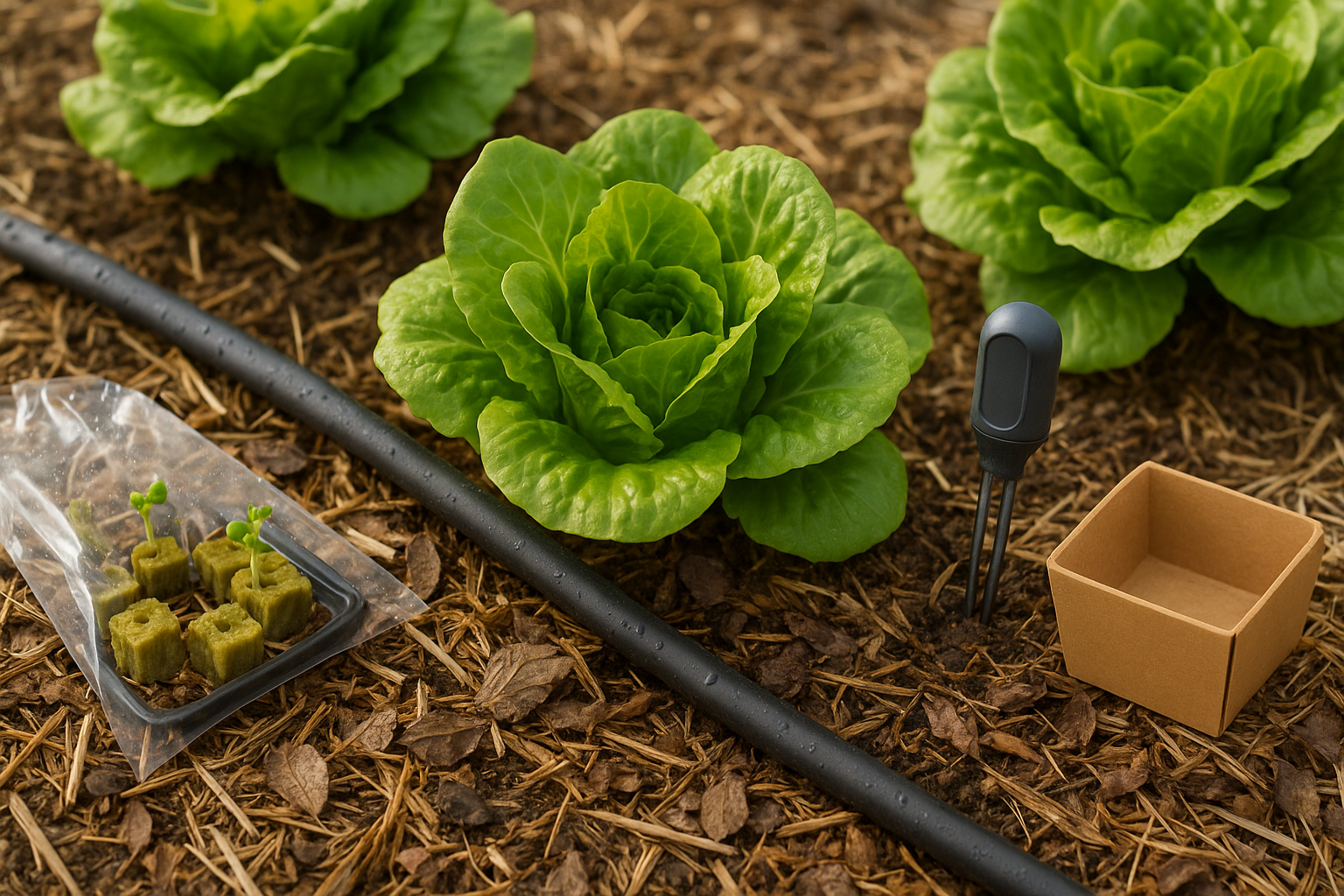
To get the most out of your lettuce crop with drip irrigation, pair it with practical strategies like mulching and fertigation. Adding an organic mulch layer—such as straw or shredded leaves—around your lettuce helps retain moisture, suppress weeds, and maintain steady soil temperatures, making your drip system work even more efficiently.
Fertigation—delivering nutrients directly through the irrigation lines—ensures the plants get a steady, precise supply of food without waste, leading to healthier, faster-growing lettuce.
For even better control, invest in soil moisture sensors or a weather-based irrigation controller. These tools monitor actual soil needs and local weather patterns, automating watering to help you avoid both under- and over-irrigation.
Over several harvest cycles, these methods can cut water usage by up to 50% compared to traditional sprinklers and reduce fertilizer runoff that harms the environment. Plus, since lettuce grows quickly and has shallow roots, even small improvements to water and nutrient delivery can significantly boost overall yields—meaning more produce from the same plot, healthier soil, and lower input costs.
The upfront investment in drip gear and sensors pays off quickly as you watch extra savings and bigger harvests stack up season after season.
Conclusion & Key Takeaways
Drip irrigation offers big advantages for lettuce farmers: it conserves water, reduces weed growth, and delivers nutrients directly to the roots—all factors that can boost yields and simplify daily work. If you’re new to drip systems, consider starting small with just one or two rows to get comfortable with installation and maintenance before expanding. Many growers find it easier to scale up once they see real results.
Have questions or your own drip irrigation experiences to share? Leave a comment below! For more tips, check out our recommended resources linked at the end of this post.
